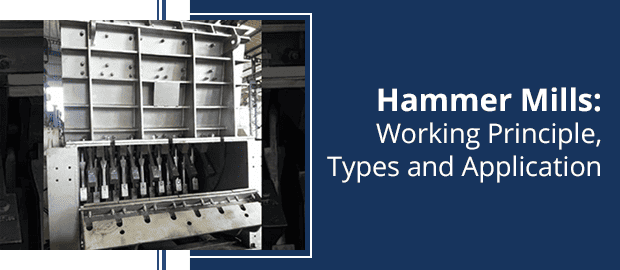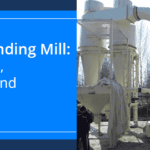Hammer mill is among the oldest, commonly used size reduction machine consisting of a series of hammers (usually four or more) hinged on a focal shaft and encased securely within a rigid metal case. They are heavy duty machines used to break and crush different feed materials (solid and hard materials). Hammer mill is used for material processing in mining, mineral, chemical, food, cosmetic and construction industries. These machines provide reasonably uniform size reduction while ensuring a reliable operation.
Hammer Mill offers many advantages, such as:
- It is a cost-effective machine with low energy requirement for operation, which saves costs.
- It can grind/crush different types of materials at high angular velocity.
- Its reduction ratio and capacity are high, irrespective of whether it is used for primary, secondary, or tertiary grinding.
- Size reduction of material happens dynamically. It is especially great for brittle material.
- The installation of the machine is simple & easy, and it offers continuous operation.
- The specified top size is produced without the need for a closed-circuit crushing system.
- It occupies a small space and is easy to clean and maintain.
Read: Vertical Grinding Mill: How it Works, Application And Advantages
Maximize Your Productivity with Hammer Mills
A] Hammer Mill Working Principle and Main Components
The process of size reduction (for feed material) is carried out by rectangular pieces of hardened steel that rotate inside the chamber at a high speed, striking the material to be milled with a powerful force. These radially swinging hammers (from the turning central shaft) help crush/grind the feed material by moving at a high angular velocity, eventually grinding the material into different sizes.
Hammer mill is made of different components that work together to achieve the intended purpose. The main hammer mill parts are:
1. Feeding Mechanism of Hammer Mill
Through the feeding mechanism, feed particles that need to be crushed/ground are entered into the crushing chamber. Depending on how a hammer mill is designed (or for what purpose), the machine may use a gravity or a metered feeding system.
- In most cases where the consistency of the material is highly important, metered feeding systems are used. These systems are high-precision machines that ensure to remove every variable that may cause irregularities in yield items.
- The gravity feeding system, as the name suggests, uses the gravitational force to feed the particles into the crushing chamber.
2. Control Box
The control box (control panel) is a part through which you can control all the activities within the hammer mill. It is an interface between the machine and the operator. From the control box, the operator can adjust the speed at which the mill crushes the material, among other things. The display screen on the control box also allows you to monitor the performance & operation of a hammer mill. Depending on the hammer mill, the control box may have different operational parameters.
3. Crushing Hammers/Knives
These hammer mill parts are the actual components that crush/grind the material in the machine. The crushing hammer and knives can be in different styles and shapes, depending on the requirement. Mostly, the hammers rotate at a very high speed that could range from 2000 to 6000 rpm. As mentioned above, the speed of the hammer can be controlled through the control panel (control box). The hammers can rotate either in a clockwise or anticlockwise direction, relying upon the course of the rotor turn.
4. Pulverizer Screens
The pulverizer screen is used after the process of crushing feed material is completed. Here, the raw (crushed) material is collected and passed through a screen that helps filter the fine material from the coarse material. The type of pulverizer screen used depends on the size of the crushed particles and the desired particle reduction size (output) required.
B] Types of Hammer Mill
The different types of hammer mills are categorised based on their industrial functions.
- Lump Breakers: The design and functionality of Lump Breakers are very different from other hammer mills. Its purpose is not to reduce the particle size but to grind the material into paste or powder. They are used to break lumps of materials like chunks of bonded chemical salts, clinker ash, lime chunks, and other similar breakable brittle materials.
- Pneumatic Discharge Hammer Mills (PDHM): The chamber walls and hammers of a pneumatic discharge hammer mill is thin compared to gravity discharge mills, even though they have similar functions. PDHM has a plate dashboard that helps with material size reduction, while the air evacuation process used for discharge helps enhance the overall output. This type of hammer mill is well-suited for lighter materials like paper, greenwood, biomass, etc.
- Gravity Discharge Industrial Hammer Mills: This hammer mill makes use of swinging hammers, mounted on a shaft. The process of particle size reduction takes place by the hammering application, plus via the particle-on-particle force. The discharge in this mill is at the bottom, which is subjected to gravity. This is why it is called a bottom discharge or gravity discharge hammer mill. These machines are primarily used for crushing glass, ceramics, dry chemicals, etc.
- Full Circle Screen Hammer Mills: These industrial hammers feature a 300-degree rotating screen that contributes to improving particle evacuation. They are best suitable for lightweight components that do not need initial grinding. These hammer mills are used for hammering spices, grasses, etc.
- Horizontal In-Feed Hammer Mills: Designed to insert materials from the side rather than the top, these mills have powerful functions and are therefore used for heavy particle grinding. These hammer mills feature trim scrap grinders and pallet grinders that help with hardcore industrial grinding.
C] Applications of Hammer Mills
Listed below are some of the most prevalent uses of hammer mills for varied applications.
-
- Food Product Grinding: Food processing industries use hammer mills to grind various types of legumes, mainly soya, nutshells, groundnuts, and different types of beans. Hammer mills with low hammer blows are used to get rid of hard nutshells.
- Powder Production: Various types of hammer mills are used for powder making in the chemical and pharmaceutical industries. The required ingredients are crushed in hammer mills to obtain an intermediate grade of powder. The mills used for powder production cannot hammer any sticky materials because there are high chances of them getting stuck on the perforated screen.
Read: Powder Conveying Systems: Different Methods and Benefits
- Material Size Reduction: Hammer mills are used for micronization in pharmaceutical industries. The medical grains need to fit inside the capsule packaging in precise quantities. Thus, they are micronized by hammer mills before they are packaged.
- Mixing of Solid Dry & Fibrous Material: They are used for combining two solid powders to produce a consistent mixture of two fibrous solid ingredients.
- Dissolution Process: They are used for formulation and quick dissolution in the chemical, food, and pharmaceutical industries. The small-sized particles dissolve faster during dissolution. Thus, hammer mills are utilized for fast formulation.
- Improve Activeness of an Ingredient: Many ingredients can bring out active reactions when added to certain formulations. These ingredients are crushed slightly to improve their activeness.
- Scrapping and Recycling Processes: They are used for scrapping purposes by the mechanical and automobile industry. Here, the irreparable overused automobile parts are scrapped by hammering, and the crushed metal is later sent for melting. New production and recycling can be carried out by using molten material.
Maximize Your Productivity with Hammer Mills
Conclusion
The quality of a reduced product relies on the quality of the hammer mill. Therefore, you must select a high-quality, innovative hammer mill from a recognized supplier for your application. You can get in touch with us to know more about hammer mills and how they can benefit your company.



